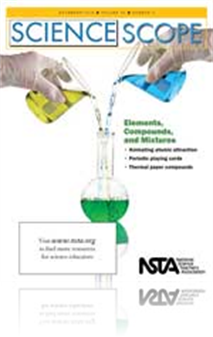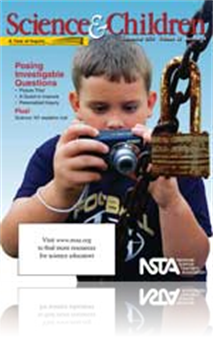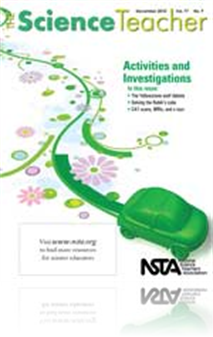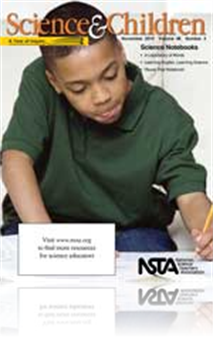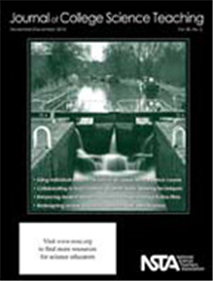All Resources
Journal Article
Science Sampler: The S<sup>3</sup>: Singing Science Students
How do music, joy, fun, and science fit into a middle school science curriculum? This article describes how the authors’ Singing Science Students learn science topics and concepts through song and then perform concerts for the entire school, wearin...
Journal Article
PD Pathways: Attending a Science Institute
For two weeks during Summer 2009, three elementary school teachers—Darcy Marcou, Melissa Lange, and Andrea Konitzer—participated in a science institute directed by Scott Ashmann, a science education professor at the University of Wisconsin-Green ...
Journal Article
Science 2.0: Invitation to Inquiry
Too often, students are not engaged in authentic questioning. Dan Meyer, a math educator, explains, “Our curricula are full of pseudoproblems wrapped in pseudocontext. We ask students to grapple with problems that only sort of resemble the real wor...
Journal Article
Science Sampler: Deal me in—Using playing cards to model the periodic table of elements
Unfortunately, the terms “resource deprived” and “science teacher” are too often paired. Gaining access to inexpensive materials to teach with serves both teachers and students well, and simple materials do not necessarily produce simple less...
Journal Article
Why Do Athletes Drink Sports Drinks?
Why does an athlete reach for a sports drink after a tough game or practice? The learning cycle presented in this article helps students answer this question. Learning cycles (Marek 2009) are designed to guide students through direct experiences with...
Journal Article
Thoughtful teachers allow students to pursue the relationship between structure and function before learning about particular organelles, usually through an analogy to a factory or some other complex system (Crooks and Sheldon 2005). In this Idea Ban...
Journal Article
Experts, politicians, and large numbers of American citizens recognize that our present dependence on oil is a major obstacle to the progress of this nation; an examination of the potential solar alternatives will likely be of considerable interest t...
Journal Article
Career of the Month: An Interview With Broadcast Engineer Glenn Leffler
Broadcast engineers maintain radio stations—their job is to keep stations on the air and making money. From rewiring a station’s equipment to fixing a transmitter on a mountaintop at 3:00 a.m., these engineers make sure that we, the listeners, ca...
Journal Article
Tried and True: The romance of the atoms—Animated atomic attractions
Since the formation of atomic bonds is active, the authors sought a way of learning through drama or kinetic activity. To achieve this goal, they developed an activity called Romance of the Atoms. The activity requires students to use computer-animat...
Journal Article
The National Science Digital Library (NSDL) provides a wealth of resources to assist teachers with easy access to standards, resources, and assessment tools. The author has found NSDL to be an invaluable tool throughout the school year. In particular...
Journal Article
The Green Room: Greening Your Science Curriculum
You do not need to significantly change your curriculum to incorporate environmental topics. There are plenty of course-specific resources that can help you green your individual course content; or, if your whole science department is “on board,”...
Journal Article
A method for elevating the thinking level of students while accommodating their digital needs is to use real-world, problem-based projects. One such project is the Poison Blog, which requires middle school students to group content that is usually ta...
Journal Article
Questions are powerful tools that are central to scientific inquiry. Given the importance of investigable questions to scientific inquiry, what can teachers do to help students learn how to generate them? Possibilities the author explores in this art...
Journal Article
Editor’s Corner: Into the Future With <em>The Science Teacher</em>
The end of the year is always a time for reflection. Although December may feel more like midyear for teachers, the end of the calendar year inevitably brings top 10 lists, reviews of the year’s best, and personal vows for improvement. But before y...
Journal Article
The New Teacher’s Toolbox: Getting a Handle on Grading
Anecdotally, colleagues have shared that they spend anywhere from 3 to 10 hours a week on grading—depending on the time of year. When you add planning time to that, it’s easy to see how evenings and weekends can be quickly eaten up by paperwork. ...
NSTA Press Book
Tried and True: Time-Tested Activities for Middle School
A compilation of popular “Tried and True” columns originally published in the award-winning journal Science Scope, this new book is filled with teachers’ best classroom activities—time-tested, tweaked, and engaging. These favorites are organi...
NSTA Press Book
Earth Science Puzzles: Making Meaning From Data
Teachers of Earth and environmental sciences in grades 8–12 will welcome this activity book centered on six “data puzzles” that foster critical-thinking skills in students and support science and math standards. ...
By Kim Kastens, Margie Turrin
Journal Article
The New Teacher’s Toolbox: When Silence Is Not Golden
Silences can be quite uncomfortable, and in front of a classroom of students, 10 seconds can feel like an eternity. Class participation is tricky because it depends on several complicated dynamics. Ideally, many students will consistently volunteer i...
Journal Article
Every Day Science: November 2010
This monthly feature contains facts and challenges for the science explorer....
Journal Article
Tried and True: Save the penguins—Teaching the science of heat transfer through engineering design
Engineers, scientists, and environmental groups around the globe are hard at work finding solutions to mitigate or halt global warming. One major goal of the curriculum described here, Save the Penguins, is to help students recognize that what we do ...
Journal Article
Point of View: A Case for Narrative Writing in Science Courses
Some time ago, the author participated in a faculty seminar on Writing in the Disciplines with colleagues from the sciences. This seminar was very productive for all participants and resulted in a number of creative strategies for helping science stu...
Journal Article
The Impact of Science Fiction Films on Student Interest in Science
Science fiction films were used in required and elective nonmajor science courses as a pedagogical tool to motivate student interest in science and to reinforce critical thinking about scientific concepts. Students watched various films and critiqued...
Journal Article
The Early Years: Documenting Learning
Children’s work documents their thinking and the details they note as they learn more. Over time, by drawing, dictating, or writing about their observations, children can reveal and deepen their understanding of science concepts. Documenting work t...
Journal Article
Instructing Students in Academic Integrity
Plagiarism is a great temptation to students in this digital age, in areas ranging from the purchase of term papers on the internet to improper citing of sources in reports to the inappropriate use of clickers in the classroom. The authors have explo...
Journal Article
Research and Teaching: Redesigning the Preexam Review Session
In a large enrollment, multiple-section course, review sessions enable efficient and consistent delivery of information to all students. A redesigned review session has been implemented to increase attendance and improve effectiveness. The new design...
Journal Article
Learning English, Learning Science
Using science notebooks effectively in the classroom can encourage students who are learning English to keep up and keep interested. English language proficiency might head the list of content areas that schools can teach properly and effectively thr...
Journal Article
Many first-year chemistry students have memorized the steps of the “scientific method” and can recite them without any prompting. But when introduced to controlled, independent, and dependent variables, they hit a brick wall. Therefore, the autho...
Journal Article
Career of the Month: An Interview With Applied Chemical Technology Professional John Engelman
Applied chemical technology professionals (ACTP) are key members of laboratory teams. From pharmaceutical testing to environmental monitoring and basic research to complex projects, they work in a variety of settings and assume many different respons...
Journal Article
Safer Science: Computer Safety in the Lab
Today, it is common to find desktops, laptops, netbooks, and specialized handheld devices in the science lab, and the internet is often used for research and collaboration between learners. The pervasive use of computer technology in high school labs...
Journal Article
The authors created an interactive reflective log (IRL) to provide teachers with an opportunity to use a journal approach to record, evaluate, and communicate student understanding of science concepts. Unlike a traditional journal, the IRL incorporat...
Journal Article
Science Sampler: Metric-asaurus—Conceptualizing scale using dinosaur models
For middle school students who have seen only pictures of dinosaurs in books, in the movies, or on the internet, trying to comprehend the size of these gargantuan animals can be difficult. This lesson provides a way for students to visualize changing...



